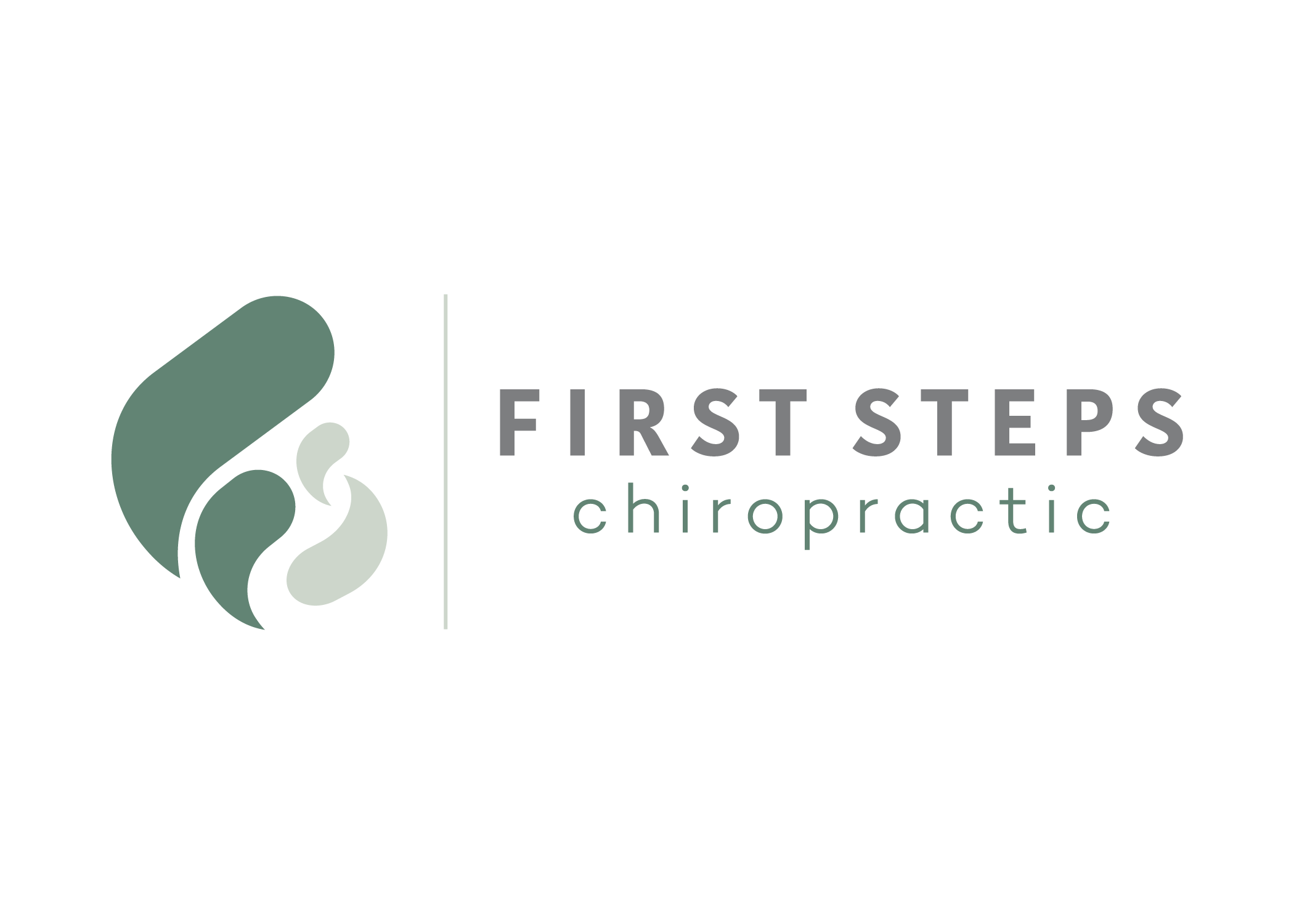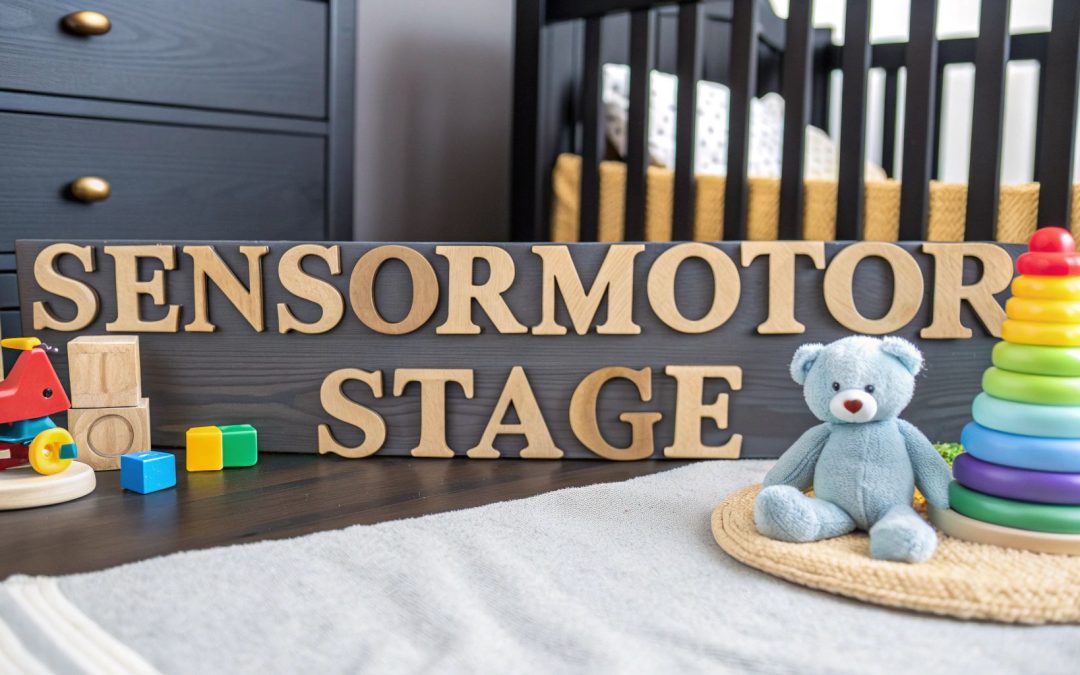Welcome to the very beginning of your baby’s journey into understanding the world: the sensorimotor stage. This is the incredible period from birth to about age two, where your infant is essentially a tiny scientist, discovering everything for the first time through their senses and physical actions.
Every touch, taste, and wiggle is a new piece of data in their grand experiment of life.
Exploring Your Baby's First Adventure in Learning
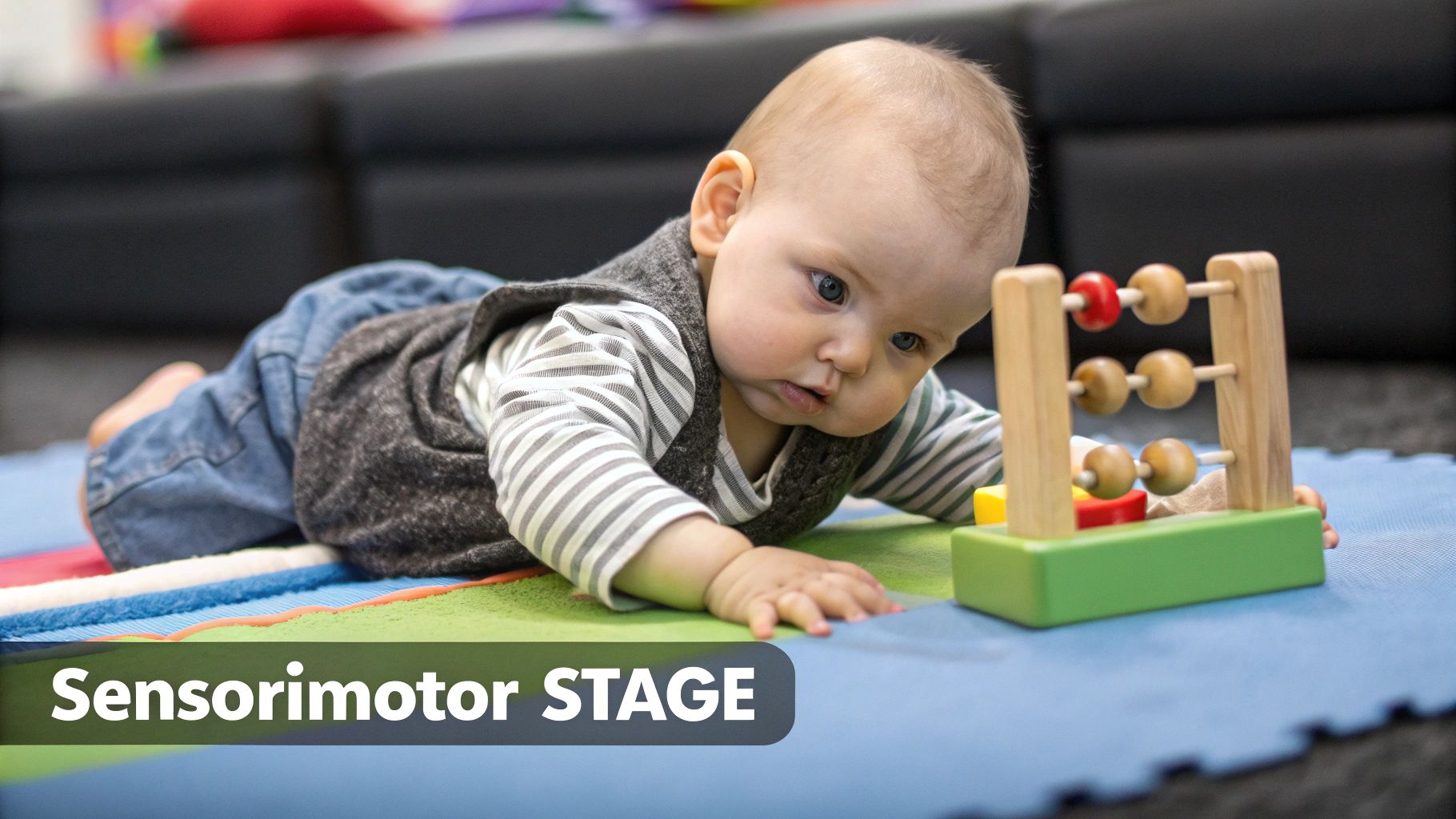
The sensorimotor stage is where your child builds their entire understanding of reality from the ground up. They don't start with concepts or mental pictures; they only have what they can directly experience. A rattle isn't a "toy" at first—it's an object that feels a certain way in their hand, makes a cool noise when they shake it, and has a specific taste when they inevitably put it in their mouth.
This hands-on exploration is the bedrock of cognitive development. As the first of Piaget's four stages, the sensorimotor stage is marked by astonishingly rapid growth. You can learn more about Piaget's developmental stages on Simply Psychology for a deeper dive.
At its core, this stage is all about connecting actions to consequences. "If I shake this, it makes a sound." "If I let go of this, it disappears downward."
These simple connections are actually massive cognitive leaps. They lay the essential groundwork for more complex thinking and lead to two of the biggest developmental milestones of early childhood:
- Object Permanence: The game-changing realization that things still exist even when you can't see them. (Hello, peek-a-boo!)
- Cause and Effect: Understanding that their own actions can make something happen in the world around them.
To help you keep these big ideas straight, here’s a quick-reference table.
Key Concepts of the Sensorimotor Stage at a Glance
This table breaks down the foundational concepts of the sensorimotor stage, giving you a quick snapshot of the major developmental themes you'll see in your little one.
| Concept | What It Means for Your Baby | Example |
|---|---|---|
| Learning Through Senses | Your baby uses sight, sound, touch, taste, and smell to make sense of everything. | Mouthing a toy to learn its texture and shape. |
| Motor Actions | Physical movements like grasping, kicking, and crawling are tools for discovery. | Repeatedly dropping a spoon from the highchair to see what happens. |
| Object Permanence | The understanding that objects and people continue to exist even when they are out of sight. | Looking for a toy after you've hidden it under a blanket. |
| Cause and Effect | The connection between an action and its immediate result. | Shaking a rattle on purpose to hear the noise it makes. |
Watching this journey from newborn reflexes to purposeful toddler actions is nothing short of incredible. Each of these concepts builds on the last, creating a strong foundation for all future learning.
Navigating the Six Sub-Stages of Development
The sensorimotor stage isn’t one long, drawn-out period. It’s more like a fascinating six-part series where your baby builds new skills at a breathtaking pace. Famed psychologist Jean Piaget broke this time down into distinct sub-stages, with each one laying the groundwork for the next.
Watching this progression helps you understand the "why" behind what your baby is doing, from their earliest gut reactions to their first real attempts at solving problems. It’s a journey from pure reflex to thoughtful, intentional action.
The First Steps From Reflexes to Purpose
The first few months are all about your baby discovering their own body and what it can do.
-
Reflexive Acts (0–1 Month): In the very beginning, your newborn is working with the only tools they have—their reflexes. They aren’t thinking about grabbing your finger; their tiny hand just instinctively closes around it. This sub-stage is all about automatic responses to what they feel, see, and hear, like sucking, startling, or grasping.
-
Primary Circular Reactions (1–4 Months): This is where we see the first spark of intention. Your baby might accidentally get their thumb in their mouth and find it comforting. The next step is trying to do it again on purpose because it felt good. These actions are called "primary" because they are focused entirely on their own body.
This infographic gives a great visual of how your baby moves from those early reflexes to the first intentional behaviors.
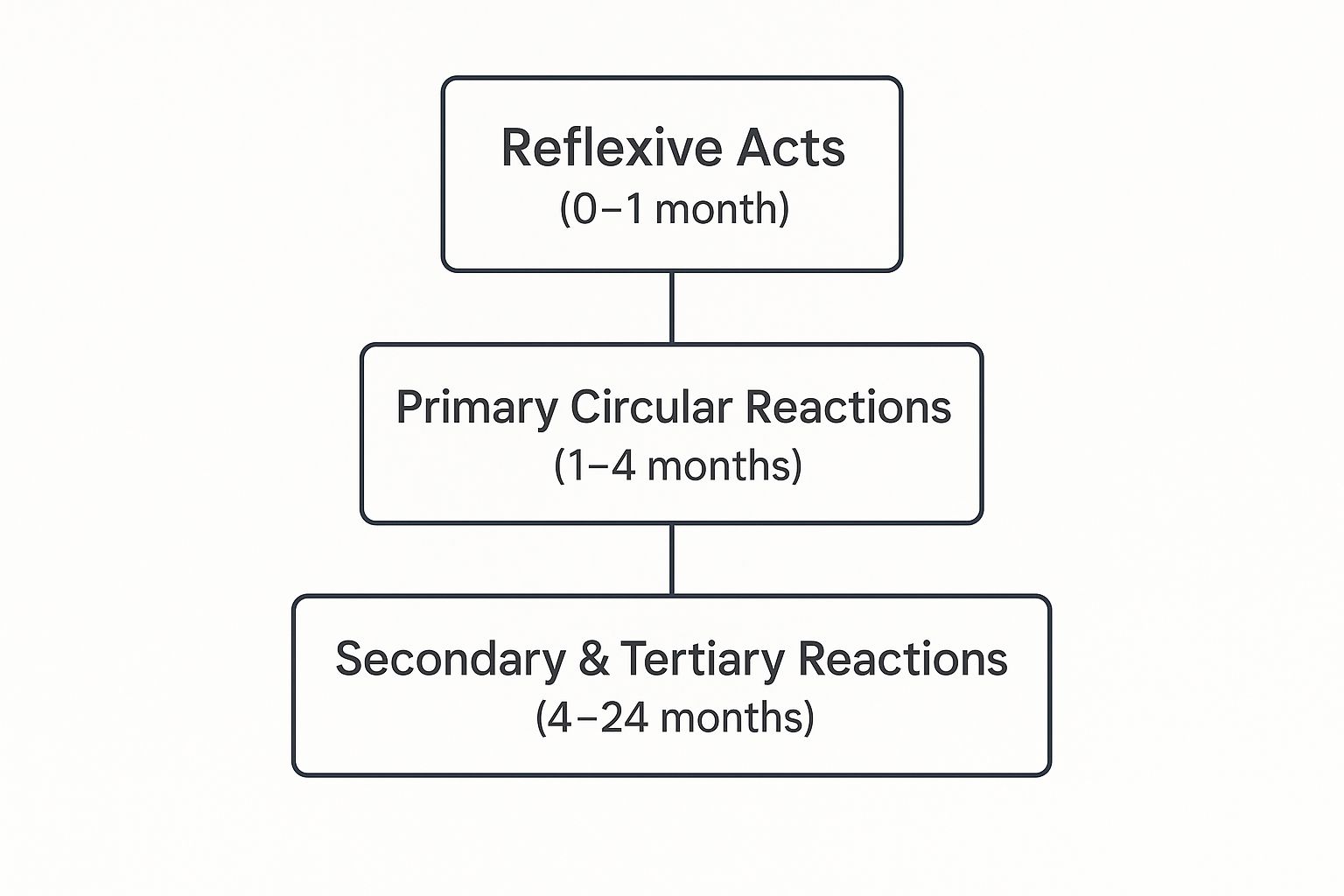
As the diagram shows, development really picks up speed here, shifting from simple, body-focused discoveries to more complex interactions with the world.
Interacting with the World Around Them
As your baby gets a bit older, their attention starts to shift outward. They're no longer just focused on themselves but on their environment, and this is where the real experiments begin.
- Secondary Circular Reactions (4–8 Months): Now, the fun really starts. Your little one discovers their actions can make things happen in the world around them. They might accidentally shake a rattle and love the sound it makes, so they do it again and again. The action is still discovered by chance, but now it’s all about external objects.
This is a huge leap forward. It’s the moment your baby realizes, "Hey, I can make things happen!" This realization is the bedrock for understanding cause-and-effect and recognizing their own ability to influence their surroundings.
- Coordination of Reactions (8–12 Months): At this point, actions become much more deliberate and complex. Your baby can now string together different movements to get what they want. Think about them crawling to get a toy, pushing another block out of the way, and then finally grabbing their prize. They are starting to plan and carry out simple, multi-step sequences.
Becoming a Little Scientist
The last phase of the sensorimotor stage is all about active experimentation and the beginning of actual thought.
-
Tertiary Circular Reactions (12–18 Months): Welcome to the "little scientist" phase. Your toddler is now an active, curious experimenter. They won’t just drop their spoon once; they'll drop it from different heights, throw it across the room, and bang it on the table just to see what happens each time. They are purposefully exploring an object's properties through trial and error. To learn more about how they understand their physical world, you can explore our guide on proprioception and its role in your child's development puzzle.
-
Early Symbolic Thought (18–24 Months): In this final sub-stage, a massive cognitive jump happens. Your child starts to form mental pictures of objects and events. This means they can think about things without them being right in front of them, which is what opens the door to pretend play and true problem-solving inside their own minds.
Understanding Your Baby's Major Cognitive Leaps
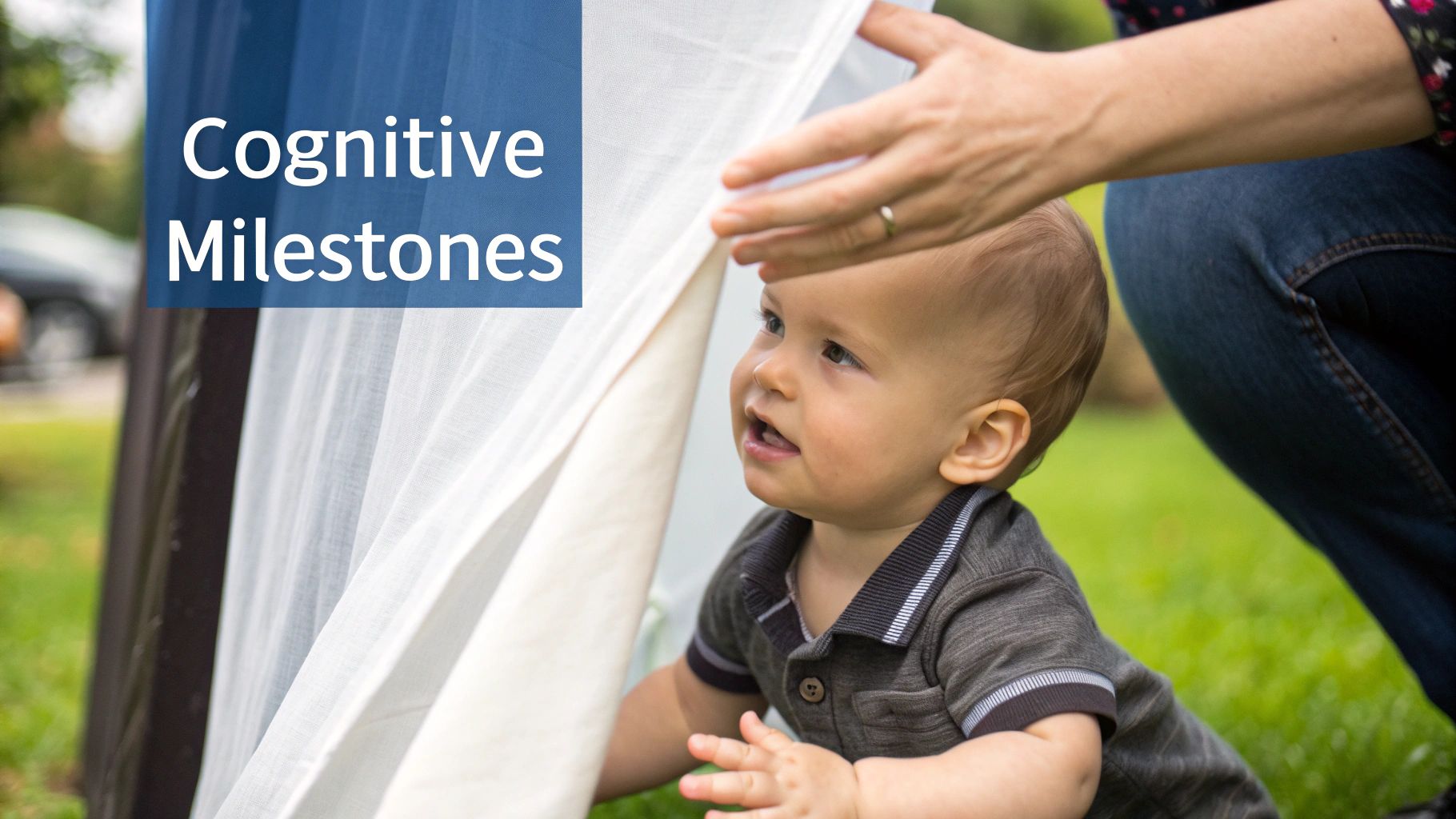
During the sensorimotor stage, your baby isn't just learning to roll over or grasp a toy. They are making monumental shifts in how they understand the world around them. Two of the biggest breakthroughs are figuring out object permanence and cause and effect. These aren't just fancy psychological terms—they are fundamental concepts that completely reshape your baby's reality.
These cognitive leaps are incredibly important. Globally, nearly 53 million children face identifiable developmental delays, and the sensorimotor stage is a period of intense brain growth and plasticity. It's a critical window for building a strong neurological foundation. You can read more about how the nervous system responds to early stimuli and supports motor milestones on PX Docs.
The Magic of Object Permanence
Ever wonder why peek-a-boo is the best game ever to a baby? It's because you are literally helping them master object permanence—the groundbreaking idea that things still exist even when they can't be seen.
To a very young infant, "out of sight" truly means "out of mind." When you hide your face behind your hands, you have, in a very real sense, vanished. As they grow and their brain develops, they begin to understand that you are just hiding. This is a massive cognitive jump and the very beginning of memory and the ability to hold a picture of the world in their mind.
Object permanence provides a sense of stability and predictability. It teaches a baby that even though they can't see their caregiver, that person still exists and will return, which is a cornerstone for developing secure attachments.
Connecting Actions to Outcomes
The second major breakthrough is getting a handle on cause and effect. This starts with happy accidents, like when a random kick of the feet makes the mobile above the crib dance and jingle. At first, it's a surprise. But over time, they realize they were the one who made that happen.
Then, the experiments begin. They start shaking a rattle on purpose to hear the sound. They push a button to see a toy light up. They gleefully drop a spoon from the high chair just to watch it fall (and get a reaction from you!). This realization that "I can make things happen" is incredibly empowering. It is the very first step toward intentional problem-solving and learning how to interact purposefully with their environment.
Fun and Simple Activities to Support Development
Supporting your little one through the sensorimotor stage doesn’t mean you need a room full of expensive gadgets or a rigid schedule. Not at all. The most meaningful learning actually happens during simple, everyday play.
When you turn these routine moments into fun interactions, you’re actively building and nurturing your baby’s developing brain. The goal is to focus on activities that stimulate their senses and get them moving—these experiences are the building blocks for how they learn to make sense of their world.
Activities for Newborns to Six Months
For the youngest babies, development is all about taking in sensory information and figuring out their own bodies. Your job is to create a rich sensory world that feels safe, comforting, and interesting.
- Tummy Time Fun: Make tummy time a little more exciting by using different textured blankets. A soft, fuzzy blanket gives a totally different sensation than a smooth, silky one. This small change helps them build crucial neck strength while their brain processes new tactile information.
- Tracking Games: Grab a high-contrast toy, like a simple black-and-white rattle, and hold it about 8-12 inches from your baby’s face. Slowly move it from side to side and watch their eyes follow. This game is fantastic for strengthening their visual tracking skills and focus.
If you’re noticing that your baby seems especially sensitive to certain textures or sounds, it can be really helpful to learn more about common sensory issues in infants and the best ways to support them.
Games for Older Infants: Six to Twelve Months
As babies start to move more and get a better handle on the world, your playtime can become much more interactive. This is a huge period for introducing the idea of object permanence.
It’s right around six to twelve months that infants begin actively looking for hidden objects. They absolutely delight in games like peek-a-boo, which reinforces their growing memory. This is a massive cognitive leap, and it’s also when separation anxiety might start to show up as they form a clearer idea of “me” versus “everyone else.”
Play Tip: Hide a favorite toy partially under a blanket and encourage your baby to find it. Once they master that, you can hide it completely. This simple game directly teaches them that things still exist even when they’re out of sight.
Ideas for Toddlers: Twelve to Twenty-Four Months
Now your little one is on the move! They’re becoming tiny problem-solvers, so your activities should challenge them to think, plan, and carry out simple tasks.
- Stacking Blocks: Offer some soft or wooden blocks and show them how to stack them up. This classic activity is amazing for developing fine motor skills, hand-eye coordination, and an early grasp of cause and effect (stack them too high, and they fall over!).
- Shape Sorters: A shape sorter is a must-have for a reason. It encourages toddlers to analyze different shapes and use trial-and-error to figure out where each one goes. This is a powerhouse for building problem-solving skills and spatial awareness.
Celebrating Your Baby's Incredible First Two Years
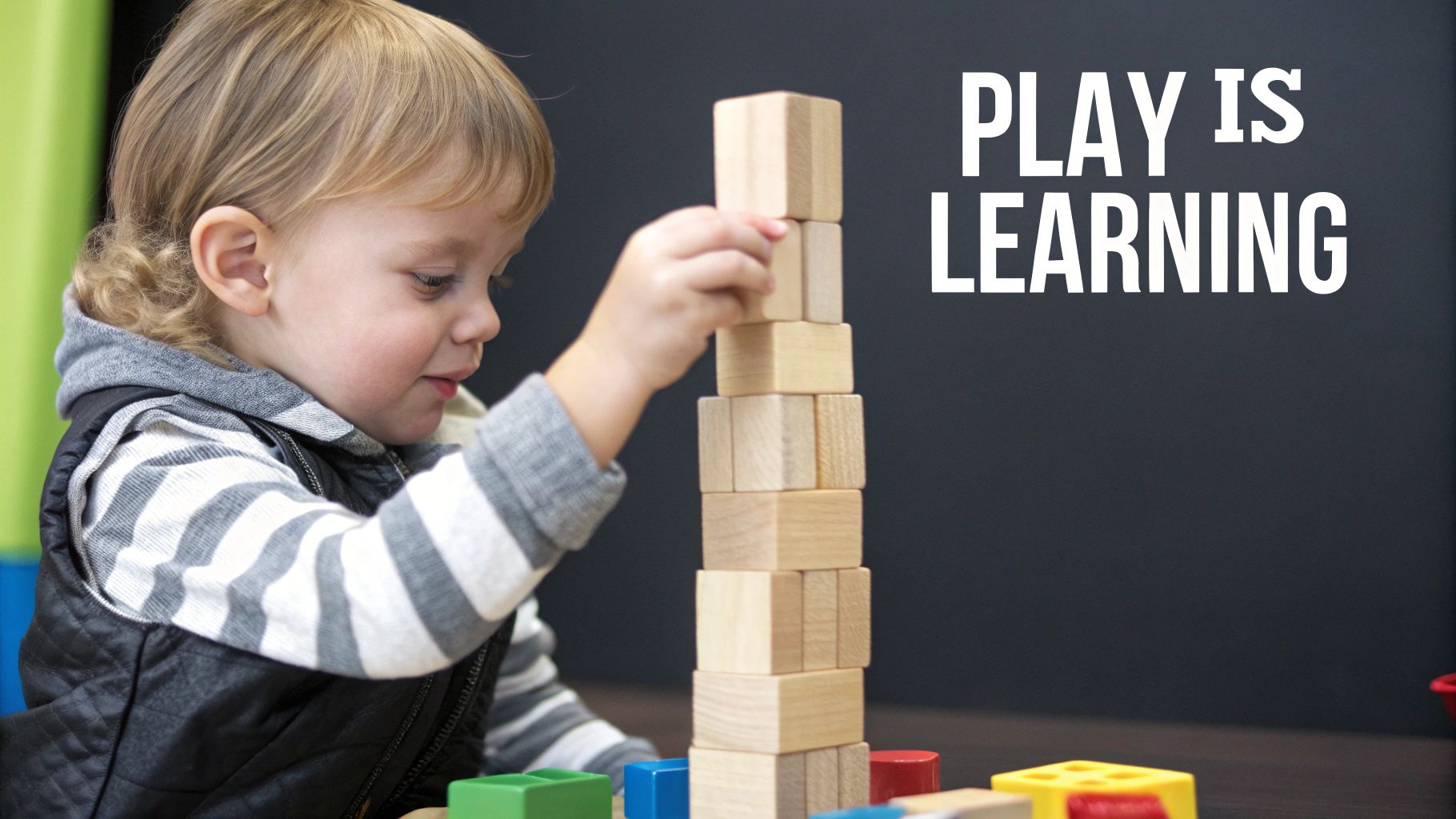
The journey through the sensorimotor stage is nothing short of amazing. In just two years, your child transforms from a newborn driven by simple reflexes into a toddler capable of purposeful action and early symbolic thought. They become a determined little scientist, actively exploring their world one grasp, taste, and step at a time.
Remember, play is the most important "work" your child does during this time. Every stacked block and game of peek-a-boo is a powerful learning opportunity.
While milestones provide a helpful guide, it’s vital to know that every child’s developmental journey is unique. So many factors influence their progress, which you can read more about in our article on the interplay of genes and experience in child development.
The best thing you can do is provide a loving, safe, and stimulating environment. Cherish this foundational period of discovery and celebrate every small step forward.
Your Questions About the Sensorimotor Stage, Answered
Even with a good understanding of the sensorimotor stage, it’s completely normal for questions to pop up. This developmental journey is unique for every single baby, and having a clearer picture of what to expect can make all the difference. Let’s tackle some of the most common concerns parents have.
What If My Child Misses a Milestone?
It’s so easy to start worrying if your little one isn’t crawling or playing peek-a-boo by the exact age you saw on a chart. But it's essential to remember that developmental timelines are guidelines, not rigid deadlines. Every baby truly follows their own unique path and schedule.
Most milestones happen within a range of several weeks or even a few months. A slight delay is rarely something to panic about. Instead of zeroing in on a specific date, it’s much more helpful to look for steady, ongoing progress. If you ever have persistent concerns about your child’s development, the best first step is always to chat with your pediatrician.
Every child develops at their own pace. The key is to look for consistent progress rather than comparing your baby to a strict schedule. A supportive environment is more important than hitting every milestone on a specific day.
How Does Screen Time Affect This Stage?
During the sensorimotor stage, learning is a full-body, hands-on experience. Babies need to touch, shake, taste, and manipulate objects to figure out how their world works. This physical interaction is what builds crucial neural pathways in their developing brains.
Screen time, on the other hand, is mostly a passive activity. It doesn't offer the rich sensory exploration that is so vital for their cognitive growth right now. While a short video call with family is perfectly fine, too much screen use can get in the way of this essential learning process. The American Academy of Pediatrics recommends avoiding screens for children under 18-24 months, with the exception of video chatting.
Can I Speed Up My Baby’s Development?
That desire to give your child the best possible start is completely natural, but trying to rush them through the sensorimotor stage isn’t the way to do it. Real, meaningful development can't be accelerated with flashcards or special apps. Your baby's brain and body simply need time to make all those important connections at their own pace.
So, instead of trying to speed things up, shift your focus to creating a rich and responsive environment where they can thrive.
- Offer plenty of floor time for free exploration.
- Talk, sing, and read to them every single day.
- Provide simple, age-appropriate toys that spark their natural curiosity.
This approach allows your child to build a strong, secure foundation for all future learning, letting them master each skill naturally and with confidence.
At First Steps Chiropractic, we believe in supporting your child’s natural developmental timeline. Our gentle, neurologically-focused approach helps ensure their nervous system is functioning optimally, providing a strong foundation for every milestone. Schedule a complimentary consultation with us today.
